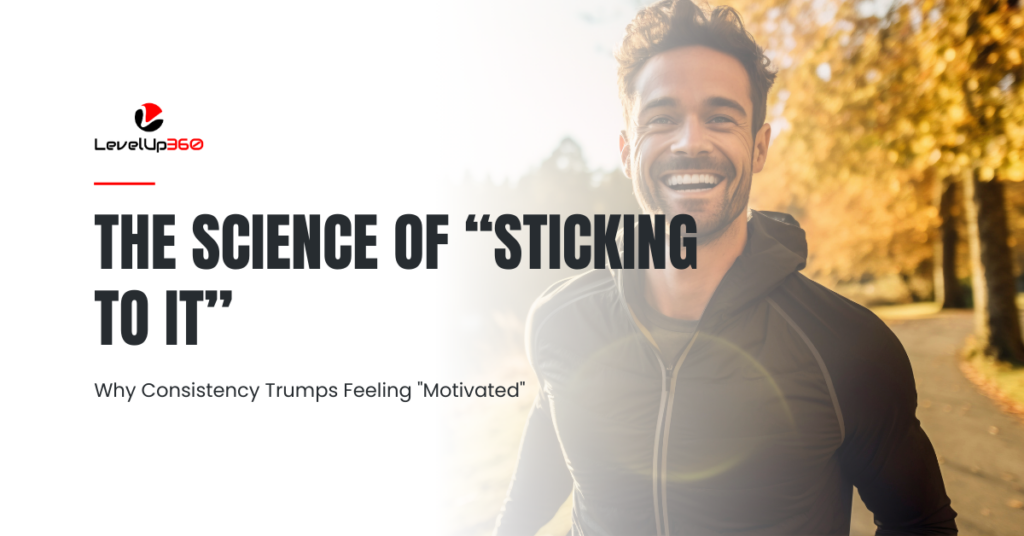
The Science of “Sticking to It”: Why Consistency Trumps Feeling "Motivated"
We’ve all been there – staring at the gym bag in the corner, kids fed and homework done, another workday behind us…yet absolutely zero motivation to lace up and get that workout in. “I’ll just go tomorrow,” we bargain with ourselves.
What if I told you that constantly searching for that elusive “motivation” to take action is fundamentally wrong-minded? Waiting until you feel motivated is the prime reason so many people struggle to stick to their health and fitness goals.
You see, motivation is fleeting. Relying on it is like building a house atop shifting sands. One day it’s there, the next…nothing.
Our greatest transformations occur when we choose to take action despite lacking motivation - that's true grit.
This harsh truth is something I recently learned the hard way. For over two years, I was burning the candle at both ends – juggling a full-time job, coaching clients, researching and delving deeper into the latest health and fitness topics, creating content…all with zero work-life balance. The daily grind slowly drained my motivation for the very passionate projects that once drove me. I found myself increasingly rationalising and giving in to immediate cravings for relaxation over taking disciplined action. It became terrifyingly easy to completely lose sight of why I started down this path in the first place. Sound familiar? Have you ever felt that soul-sucking demotivation seep in from the grind?
Ironically, I already knew there was a far more sustainable and reliable path to consistent action – one that doesn’t depend on feeling “motivated.” It’s the same wisdom I preached to my clients and readers. However, once trapped by the unrelenting grind for too long, I completely lost focus and stopped leveraging the strategies I knew could rekindle my passion. By understanding the underlying psychology behind motivation itself, I have been able to re-implement habits and systems strategically in my favour. This has allowed me to re-balance my life and find my way forward again.
The Problem with Relying on Motivation
At its core, motivation is comprised of the internal and external forces that drive goal-oriented behaviour. It encompasses the desires and reasons we take action to fulfil our needs and pursue our goals.
Intrinsic motivation arises from personal satisfaction and enjoyment of an activity itself. An artist painting for the sheer joy of creating is intrinsically motivated.
Extrinsic motivation, on the other hand, is fuelled by external rewards like achievements, money, and recognition. An employee working overtime to secure a bonus is extrinsically motivated.
While powerful drivers, both intrinsic and extrinsic motivation share the same inherent flaw – they are temporary states. They ebb and flow based on circumstances and emotions.
Even worse, research shows that motivation often follows action rather than preceding it. So waiting until you feel motivated to start can become a perpetual cycle of inaction.
This is fundamentally why motivation alone is not a reliable strategy. What you need is something more sustainable and adjustable – the key is consistency.
The Power of Forming Consistent Habits
Imagine two friends, John and Elaine, both wanting to get fit and strong. John relies on motivation alone, working out only when he feels like it. Elaine focuses on building consistent habits and systems that reinforce her efforts.
Each morning, Elaine wakes up and immediately puts on her workout clothes laid out the night before. This small habit “stack” links exercise to her existing morning routine. Her workout app is preloaded each week, laying out every exercise, set, and rep.
Some mornings, Elaine may not feel particularly motivated – yet her habit ensures showing up becomes far easier than blowing it off. Small successes like finishing her workout release dopamine, strengthening that habitual behaviour pattern.
Over time, Elaine conditions herself through consistency. Exercise morphs from a white-knuckle discipline into an ingrained lifestyle. Her workout becomes something she just “does,” like brushing her teeth.
John, however, remains at the mercy of his fleeting feelings each day. When motivated, he goes all out only to inevitably fall off when motivation fades. With no rituals or routines in place, John has to summon motivation from nothing each time.
Can you see the difference? Consistency always defeats motivation through sheer force of routine and habit.
The Psychology Behind Finding Consistency

So we’ve established that consistency trumps motivation…but how exactly can you go about making consistency your prime motivator? To find the answer, we must look within – to the psychology driving our behaviours.
Have you ever put off starting a workout regimen until “tomorrow” because you crave more immediate gratification? There’s a psychological factor called “temporal discounting” which hard-wires our brains to place greater value on rewards in the present moment over future benefits (like feeling accomplished after a training session).
Additionally, psychologists identify the “empathy gap” – our brains’ inability to emotionally relate to and appreciate the mindset of our future self. On some level, our current self sees our future self as a “different person”. With that workout-loving future, you may as well be a stranger.
Between temporal discounting pushing us toward immediate rewards and the empathy gap disconnecting us from our future desires, our brains are fundamentally wired against taking action unless we implement strategies to overcome it.
This is where “keystone habits” come into play.
Your Keystone to Consistent Change
Do you recall learning about the principle of archways, where a central keystone at the highest point locks all other supports into place? The same principle applies to our habits – certain “keystone” habits create a cascading effect of positive changes across multiple areas of our lives.
Common keystone habits include regular exercise, waking early, and mindful nutrition. For example, my sister-in-law found the most success focusing solely on simply waking up an hour earlier each morning for 100 days straight (including weekends) and doing 3 sets of a single exercise.
Even if she didn’t feel like being productive right away, she celebrated just getting out of bed and doing one exercise as a small win and a dopamine boost. Soon, being awake early naturally motivated her to increase the number of exercises, her overall daily activity, and more.
Over those 100 days, that simple wake-up habit sparked a chain reaction in other areas of her life. Had she tried overhauling everything at once, however, she may have become overwhelmed and surrendered. The keystone habit made consistent action feel almost effortless.
So I challenge you to ask yourself – what is the one habit, if you committed to it every single day no matter what for 100 days, that could create positive ripples across your entire lifestyle?
Make it small and sustainable, not some outrageous challenge to burn yourself out again. Commit to it absolutely. Use a calendar to track your streak and witness the positive momentum build.
Aligning Your Actions to Performance, Not Just Outcomes
Another key pitfall to sustaining motivation is fixating on outcome-based goals that depend on delayed gratification (such as weight loss on the scale). When the scale doesn’t seem to budge despite our efforts, deflating demotivation inevitably sets in.
Have you ever felt enormously frustrated that your weight didn’t change despite hitting the gym consistently? This is a common complaint – and it stems from misaligning our actions and expectations.
You see, exercise is not primarily about losing weight through calorie burning. Its greatest value is building lean muscle, improving strength and physical capacity, and enhancing cognitive and mental performance.
When our only measure of progress is a number on the scale, we lose sight of these internal metrics directly reinforced by our training regimen itself. Did you lift more weight today than last week? Did you notice feeling more focused and energetic after your workout? These are the true driving motivators, not just weight fluctuations.
It’s often said that the most reliable form of motivation is internal – doing something for the inherent reward it provides within ourselves. By shifting our focus to measurable performance aims like strength milestones, we tap into those immediate, self-motivated feedback loops.
Reframing the "Struggles" as Positive Signs of Growth
At this point, you may be thinking – “That’s all well and good, but what about dealing with the inevitable dips in motivation, energy, and willpower along this journey?”
Since our old friend’s motivation (and its cohorts’ willpower and perceived energy) never sticks around too long, we must maintain perspective through the valleys. This leads us to a remarkably freeing mental shift:
What if, instead of interpreting that demotivating energy drain as a negative force, we reframed it as a positive sign of forward growth?
After all, feeling perpetual motivation and endless drive would likely mean coasting through life without expanding our comfort zones or resilience. Our greatest transformations occur when we choose to take action despite lacking motivation – that’s true grit.
So next time you catch yourself making excuses to stay comfortable and delay taking action toward your goals, recognise it for what it truly is – your brain’s self-preservation trying to keep you stuck in mediocrity.
The mindset shift becomes: “I feel unmotivated, which means this is the exact thing I need to overcome. This is an opportunity to practice showing up without the crutch of emotion.” That initial resistance becomes oddly inspiring rather than discouraging.
Remember, consistency creates motivation, not the other way around. Viewing struggle as positive evidence you’re taking the right action steps can be a powerful driving force.
The Path to Lifelong Motivation

To summarise, here are the essential strategies we’ve discussed for developing sustainable motivation over the long haul:
- Reframe the struggles against taking action as positive signs you’re expanding your comfort zone, not negatives to be avoided. Resistance is evidence you’re doing the right things.
- Set goals based on intrinsically rewarding activities and measurable performance benchmarks that provide instant gratification, not just long-term outcome focuses like weight loss.
- Reduce motivational friction by creating habits and systems that make consistent action easier, such as laying out gear, pre-planning workouts, building habit “stacks,” and more.
- Identify and commit to one “keystone habit” for 100 days that can create a cascading effect of positive change across multiple areas of your lifestyle.
- Most importantly, Realise you don’t need to constantly feel “motivated” to drive momentum. That fleeting energy comes and goes. But through establishing consistency in your daily actions and habits, your life can transform regardless of how motivated you feel at any given moment.
Believe me, after getting stuck in that draining daily grind and burning out completely, I wish I had re-committed to the principles of prioritising consistent habits that I already knew, instead of chasing temporary motivation. By losing sight of those strategies amid the daily relentless demands, my passion faded dramatically. Had I implemented habits and systems to sustain consistent action through that overwhelming period, rather than depleting my motivational reserves, both my output and fulfilment would have remained consistently stronger.
Instead of falling into the motivation trap again, identify your keystone habit and start tracking your progress today. It may feel intensely unmotivating at first – that’s the precise sign you’re on the right path. Celebrate those small daily wins, let motivation follow action, and leave the unsustainable pursuit of constantly “feeling motivated” behind.
Recommended reading
Recommended reading
Additional Resources
Feeling in control of your health
If you are interested in improving your health and wellness, check out other resources such as Our Blog, Free Resources and/or join our private Body-Mind Transformation Secrets Community on Facebook, and go on an even deeper dive with me to uncover how to succeed in your health and wellness goals.
You may also be interested in our Sleep Secrets Cheat Sheet. It is a great resource with strategies to fix and optimize your sleep which is crucial to succeeding in your health and wellness goals.
Resources
Pictures








